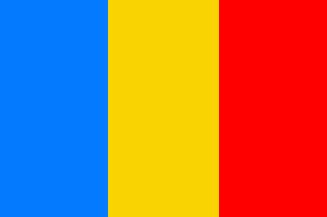
image by Jaume Ollé, 28 October 1998

Last modified: 2021-01-01 by rob raeside
Keywords: italy | parthenopean republic | naples | napoli |
Links: FOTW homepage |
search |
disclaimer and copyright |
write us |
mirrors

image
by Jaume Ollé, 28 October 1998
See also:
Vertical tricolour light blue - yellow - red (3-FEB-1799).
Alessandro Martinelli, 29 January 1996
According to Whitney-Smith the Carboneri flew a tricolor of
black, red and blue, which according to him was used in the
Parthenopean Republic, which he places in 1789 And I remember
also reading (somewhere else) about another flag, a black flag
with Vesuvios in eruption, used by italian revolutionaries at one
time. Does anyone know more about the use, history and (not the
least) the design of these flags?
Knut A. Berg, 18 June 1998
The idea of the Parthenopea Republic flying a Carbonari flag
is utterly wrong. It is a recurring mistake, we believe coming
after the publication of that statement on Smith's book.
Carboneria is a somewhat later society, developed in Southern
Italy and spread all over the country (and outside the national
borders!).
Pier Paolo Lugli, 29 June 1998
Kingdom of Two Sicily was partially ocupated by French, and in
the Napolitan part was created the Parthenopean republic (1799).
The flag was used until 1799.
Jaume Ollé, 28 October 1998
Republic Parthenopea was proclaimed in South Italia (in
territory of Dos Sicilias) 1799 under French influence (the
Borbons retain Sicily). Was retaken by the Borbons on 1799 until
1806, when it was created as the Kingdon of Naples, attribued to
Murat. Reported is a flag white, red and black According
Zigiotto, no evidence of flag exist, and the french flag is
supposed in use.
Jaume Ollé, 28 October 1998
the Neapolitan Republic (original name of those times:
Repubblica Napolitana) occurred in 1799, more precisely, from
January to June 1799.
Carmine Colacino, 9 December 1999
According to the "Piccola Treccani" Encyclopedia
(Treccani is the Institute of the Italian Encyclopedia, a
national institution), the flag of the Parthenopean Republic was
blue, black and red. The colours were exactly the same of the Carboneria, but in a different order.
Guido Abate, 6 December 2002
As I already pointed out there is a common mistake when
referring to Repubblica Partenopea flag as a Carboneria's blue -
black - red tricolour. This dates to a later period and was used
during riots. The most noteworthy display in Southern Italy was
at Nola (close to Naples) ca. 1820 - 1821 when Carbonari set-up a
temporary government. The Repubblica Partenopea adopted and used
a vertical tricolour in blue / yellow / red. There is a number of
evidences available about the 1799 revolution at Naples and the
following creation of the Republic, whose official name was
Repubblica Napoletana, as shown in the official documents of the
provisional government. A famous painting shows the freedom tree
with blue / red / yellow flags all around and hanging from the
windows of the nearby buildings. It was January 27th, 1799. A few
days earlier (on 19th) the French flag was hoisted beside the
town colours (yellow and red): joining the French blue with
Naples colors made the new flag. At the beginning of February,
probably on the 3rd, the colours were rearranged in blue / yellow
/ red, as reported by the magazine "Il Monitore
Napoletano" number 30: "la bandiera mostra i colori
della nostra repubblica: blo' - giallo - rosso" (the flag
displays the colours of our republic: blue - yellow - red. Blo'
is an old fashioned word for the modern Italian blu). In any
case, even if the colours were well defined, their arrangement
was not and also horizontally striped flags are known. There was
a National Guard (Guardia Nazionale) as well. Her flag was in the
national colours, disposed in a diagonal fashion, with the
consular fasces, a Phrygian cap and two oak branches overall.
There were slogans on the front and the back. I do not have a
picture, only a description. The author was Enrico Colonna, an
architect, and it was adopted sometime in February 1799. A
volunteer legion is known too: the Legione Calabra. It was made
of volunteers to be sent against the Royal supporters. It was
first presented on March 20th, 1799. Her flag was black with
three words positioned on three rows: vincere (to win) -
vendicarsi (to get revenge) - morire (to die).
Source: Aldo Ziggioto in "Armi Antiche",
Roberto Breschi in "Le bandiere degli Stati Italiani dal
1700 ad oggi" (flag poster and manual issued to remark 30
years of the CISV - Centro Italiano Studi Vessillologici, 2002)
and personal communication from Massimo Galoppa (referring to the
reissue of a book published on 1899 to remind 100 years from the
revolution of Naples).
Pier Paolo Lugli, 10 December 2002